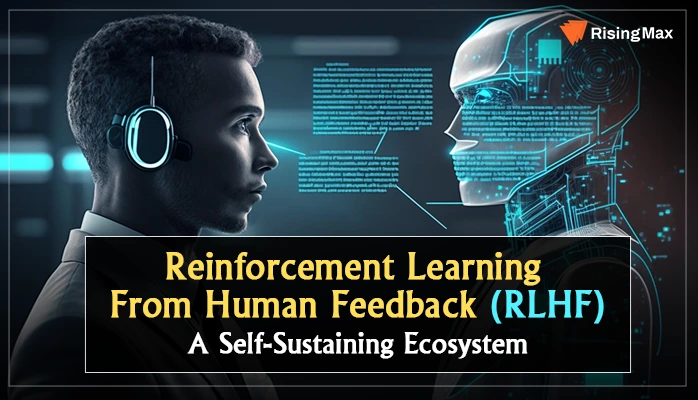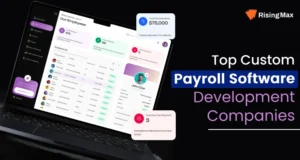We live in a world where technologies like AI and ML transform and directly impact our daily lives. For this reason, IT companies worldwide are in a race to build highly advanced solutions based on AI and ML. As the development race intensifies, promising AI-based software like ChatGPT is getting introduced and opening up new possibilities.

Reinforcement learning with human feedback (RLHF) was introduced to the world much before the ChatGPT. But there’s no denying the fact that the huge success of the ChatGPT software brings RLHF into the limelight.
The ability of this algorithm to directly learn from human feedback and deliver meaningful and helpful human-like responses. This opens up endless possibilities and is more vital for businesses than ever to incorporate this revolutionary technology.
If you are planning to build a reinforcement learning from human feedback (RLHF) based software solution, then reaching out to our expert team can be a good start. Our team leverages its expertise in AI and ML technologies to build a perfect generative AI solution that matches your business needs. Want to become a technology front-runner in your business niche? Schedule a FREE business consultation call and discuss your RLHF project idea under a non-disclosure agreement with our experts TODAY!
Before delving deep into the topic, let’s first start from the basics and understand more about reinforcement learning from human feedback (RLHF).
What Is Reinforcement Learning From Human Feedback (RLHF)?
Reinforcement learning from human feedback (RLHF) is an ML-based algorithm that works on the “reward model” and learns directly from human feedback. The ability of an algorithm to predict if the given output is good (high reward) or bad (low reward) makes it a highly advanced machine-learning technique.
The combination of human feedback and RL-based AI models is termed a significant breakthrough as it perfectly aligns with human values. For this, RLHF-based models are deployed in various applications like robotics, NLP, and game-playing.
Types of Reinforcement Learning with Human Feedback
When it comes to reinforcement learning with human feedback, there are basically two types of reinforcement learning. Let’s discuss them in detail one by one;
1. Positive Reinforcement
It is defined as an outcome that enhances the overall system’s performance and efficiency. Positive actions directly impact and strengthen the system. However, positive action over an extended period of time results in over-optimization, directly affecting results.
2. Negative Reinforcement
It is defined as an outcome that negatively impacts the system’s overall efficiency. Negative reinforcement is a clear metric of minimum stand-alone performance of reinforcement learning with human feedback algorithms.
How RLHF Works and Why Combine Reinforcement Learning With Human Feedback?
The working of reinforcement learning is quite simple. It is an algorithm that learns from human feedback and provides output based on a “reward model”. The concept of using human feedback in training an algorithm results in getting feedback that perfectly aligns with human values.
In this section, we will discuss why combining reinforcement learning with human feedback and how is improving customer experience and complex processes. Let’s delve deep and understand step-by-step reinforcement learning with human feedback.
Step 1: Begin with the Pre-Trained Model
You can start reinforcement learning by deploying a pre-trained model with a vast amount of data to learn and generate outcomes.
Step 2: Output Optimization
With a pre-trained model and a vast amount of data, reinforcement learning will start learning and providing outcomes based on its understanding. Further training and assistance are required to optimize output and generate more accurate results.
Step 3: Reward Model
With a reward model training, you can ensure that all the outcomes are scored accordingly to improve the overall accuracy and improve quality.
Step 4: Desirable Feedback
This technique empowers the algorithm to learn from previously generated outcomes, learn and provide desired feedback.
Step 5: System Testing
In the end, the RLHF system will be put to the test in real-world scenarios, and predictions will be analyzed to evaluate the system’s overall efficiency.
Reinforcement Language With Human Feedback: System Architecture
There are three major components of reinforcement language with a human feedback system. For a better understanding, let’s discuss these three major components of reinforcement language with human interface architecture.
Environment
When it comes to the RLHF architecture, the environment is defined as the ecosystem where the algorithm is trying to learn. A human feedback interface can provide specific input and feedback to the reinforcement learning algorithm.
Reinforcement Learning Algorithm
The next major component of the architecture is the reinforcement learning algorithm. The algorithm operates and learns from human data. Human feedback can be directly incorporated into the RL algorithm to ensure optimal action.
Human Feedback Interface
When it comes to the human feedback interface, there are multiple forms, such as mobile or web-based interfaces. Human evaluators can leverage these interfaces to interact with the system and share feedback.
Relationship Between Reinforcement Learning With Human Feedback & ChatGPT
Reinforcement learning with human feedback and ChatGPT are closely related. ChatGPT is built on reinforcement learning with human feedback. RLHF makes the ChatGPT capable of providing valuable, helpful, and human-like output.
During the initial development stages, human AI trainers engaged in conversations as user and assistant roles for training and testing purposes. Engaging in real-world-like conversations enables chatGPT to predict the most appropriate response for the input provided.
This started the initiation of collecting human feedback and AI trainers employing reinforcement learning algorithms for generating responses.
Align the current state of IT with your business strategy by hiring the most trustworthy Software Development Company
Benefits of Reinforcement Learning With Human Feedback
ChatGPT is just one example of reinforcement learning with human feedback that clearly shows this technology’s benefits. In detail, let’s look at the various advantages of reinforcement learning with human feedback.
Enhanced Performance
Integration of reinforcement learning with human feedback algorithms within business processes results in improved performance and efficiency of the overall system. The ability of this technology to understand complex human preferences and provide more accurate and relevant responses.
Easy Adaptation
As reinforcement learning with human feedback, learn from input provided by various human AI trainers and experts. This enhanced flexibility enables RLHF to easily adapt to any environment as compared to any conventional AI-based algorithm.
Unbiased System
The reinforcement learning system learns directly from human data and feedback; it effectively addresses the issues of biased opinions. Trained on human-generated data makes the RLHF system more aligned with human values.
Continuous Enhancement
The reinforcement learning with the human interface continuously takes feedback from human trainers to improve and generate high-quality output. The continuous adaptation as per feedback and continuous enhancement make the overall highly efficient.
Improved Safety
Human trainers involved in improving and enhancing the overall RLHF system eliminate loopholes within the system and pave a platform for secure user interaction.
Reinforcement Learning With Human Feedback Use Cases
When we talk about reinforcement learning with human feedback use cases, ChatGPT will be the first software that comes to our minds. However, RLHF use cases are not limited to any specific domain, and we are going to discuss these use cases in detail.
Game Playing
Reinforcement learning from human feedback is now employed in game playing to enhance players’ overall gaming experience and improve performance. Direct and unbiased feedback can be provided by experts for implementing new game strategies and different game scenarios. A well-trained algorithm will assist players in the game and enhance their decision-making capabilities.
Personalized Suggestions
RLHF algorithm can be trained to learn the preferences of different users and provide personalized suggestions based on their interests. Experts can test the efficiency of the system by evaluating the recommended products. Employing this algorithm assists in providing personalized product and service recommendations, thus enhancing the user’s overall experience.
Training AI
Reinforcement learning with human feedback creates an ecosystem for experts to interact with the AI and train them accordingly. Leveraging these tools, AI-based algorithms can be trained to quickly adapt and operate in a new environment safely and efficiently. For this very reason, RLHF is employed in manufacturing and warehouse operations to optimize the overall process and enhance safety.
Personalized Learning Experience
For creating a more personalized learning experience, the RL algorithm can be trained using teachers’ feedback to learn which learning methodology works perfectly for a student. Leveraging this information, the algorithm can implement personalized learning techniques to enhance the overall learning experience.

How Much Does It Cost To Build An RLHF-Based System?
The estimated development cost and ROI play a major role in deciding whether to proceed with the project. However, similar to software development, there are multiple factors that impact the RLHF-based software development cost.
For this, sharing an exact RLHF system development cost becomes difficult without understanding the core project requirements and other associated factors.
Here are the top factors that directly impact the reinforcement language with human feedback software development cost;
- Type of RLHF system.
- Deployment environment.
- Training required and complexity.
- Location of an RLHF app development company.
- Project size and development time frame.
- Tech stack required.
- Team strength.
In a dilemma, whether to invest in reinforcement learning with a human feedback system or not? Then, connect with our experts at RisingMax Inc. and discuss your project idea in detail. Our team will answer all your project-related queries and share a customized project development cost ASAP.
Most AI development companies charge $65k to $80k for building reinforcement learning from human feedback software solutions. Note: The overall project development cost might increase depending on the above cost-driving factors.

Why Choose Us As Your RLHF Software System Development Partner?
As a leading AI and ML software development company in NYC, USA, we assist businesses worldwide in implementing next-gen software and upgrading existing IT infrastructure. Over wide-ranging expertise in building software solutions for clients in different business verticals gives us a competitive edge.
Here’s why you hire us;
- Unmatched RLHF development expertise.
- Advanced and reliable solutions.
- Customized RLHF platform.
- Experienced development team.
- Transparent pricing policy.
- 24*7 customer support.
Connect over a FREE business consultation call and share your RLHF project needs with our experts Today.











